The 2019 NHL Playoffs start tonight, and one of the most interesting series of the first round will be the Dallas Stars versus the Nashville Predators. And although the Predators and Stars are familiar with each other, this article is written with you, the Stars fan, in mind. It’s to serve as an introduction to the 2018-19 Predators.
Related: How do the Predators and Stars Stack Up?
That way, during the game, you don’t have to look up player numbers, but can focus on the on-ice action. Considering how close the regular-season series was between the two teams, this series figures to be a great one. Enjoy, and good luck.
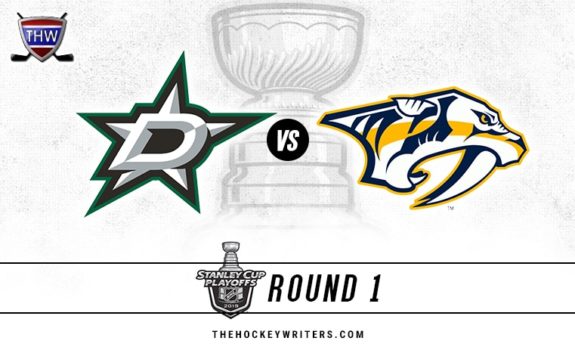
A Brief History of the Predators
The Predators joined the NHL as an expansion team for the 1998-99 season. They failed to make the playoffs for the first five seasons, finally doing so in 2003-04. That started a run of reaching the playoffs in seven of eight seasons, but only advanced past the first round twice. After two down seasons in 2012-13 and 2013-14, they again reached the postseason in 2014-15, which started a run of five straight appearances that continues today. They’ve won at least one round each of the past four postseasons, and made a run to the Stanley Cup Final in 2017.
In the Predators’ 20 seasons, they’ve played the Stars 84 times, all in the regular season, with a 38-40-1-5 record against them. Since the 2013-14 season, they’ve both been members of the Central Division.
2018-19 Predators
The 2018-19 Predators are coached by Peter Laviolette, who’s been behind the bench since the 2014-15 season. As Nashville’s head coach, he has a 229-128-53 record in the regular season and a 30-25 record in the playoffs. Previously, he coached the New York Islanders, Carolina Hurricanes and Philadelphia Flyers, winning the 2006 Stanley Cup with Carolina.
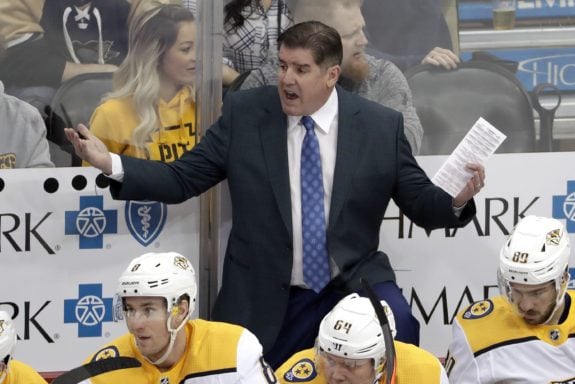
At the helm is general manager David Poile. He’s been GM since the franchise’s inception and is the winningest general manager in league history.
Related: Predators’ Keys for Playoff Success
The Predators’ captain is Roman Josi, and Mattias Ekholm, Ryan Ellis, Filip Forsberg and Ryan Johansen rotate as alternate captains. Josi has been the captain since the 2017-18 season.
The Predators had a 47-29-6 record with 100 points. They won the Central Division by one point. They finished 19th in the league with 236 goals scored and tied for third with 212 goals allowed. The Predators and Stars faced each other five times this season, and the Predators won three games, with two occurring in overtime. Now onto what to watch for from the Predators and who their players are.
Starts with the Blue Line
If you’re unfamiliar with the Predators, they are built around their blue line. Their top four is among the league’s best, and it allows players who would be top-four defensemen on most teams to play on the bottom pair. They limit chances, generate offense and transition well. While there isn’t a true first and second pair, we’ll start with the pair of Ryan Ellis (#4) and Roman Josi (#59).
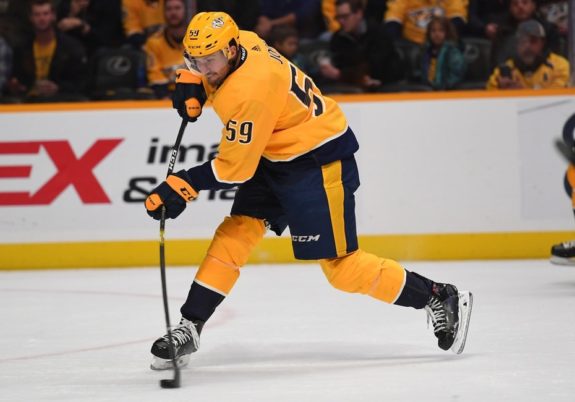
Josi finished the season with 15 goals and 56 points in 82 games. He was second on the team and tied for eighth among NHL defensemen in points. Ellis had seven goals and 41 points in 82 games, the first time he’s played a full season.
Related: Stars vs. Predators: A Rivalry in the Making
Both are great with the puck, and oftentimes Josi operates like a fourth forward, which can lead to turnovers and odd-man rushes for the opposition. This means Ellis is the more defensively responsible of the two and is great at making reads in the defensive zone. Both are excellent skaters and their handedness balance makes them a dynamic pair. Both play in all situations.
Next up is the Mattias Ekholm (#14)/P.K. Subban (#76) pair. Like the top pair, this pair also has handedness balance. Both players are strong with and without the puck, with Subban being the more dynamic scorer, hence his 2013 Norris Trophy.
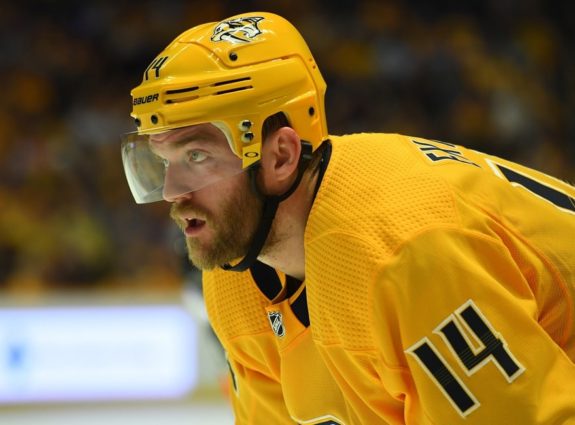
Ekholm is the better one-on-one defender and is rarely out of position. 2018-19 was a career season for him with eight goals and 44 points in 80 games. Subban had a down season with nine goals and 31 points in 63 games but played his best down the stretch. While Ekholm is steady and consistent, Subban can look disengaged, leading to costly penalties, or worse, goals. When both are on their games, they form one of the league’s best pairs, especially in a shutdown role.
Related: 2018-19 Season & Playoffs by the Numbers
Veteran Dan Hamhuis (#5) has been the consistent member of Nashville’s third pair. He played with several partners this season, but most recently it was rookie Dante Fabbro (#57) after his college hockey season ended. Hamhuis is a defensive defenseman who takes the team’s most difficult matchups, and usually wins them. While he was a two-way blueliner for much of his career, he only had five assists in 57 games this season.
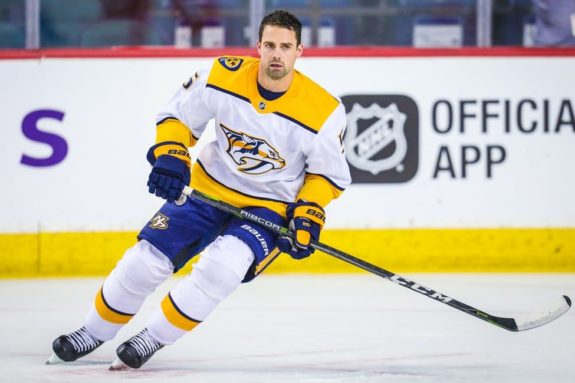
Fabbro’s presence on the bottom pair has been great because he’s a two-way defenseman and provides offense that had been missing from the pair all season. A right shot, he creates balance on the pair, and has looked comfortable since debuting. Has played fairly conservative, but is an excellent skater whose best skill is finding the right option on zone exits.
The Forwards
On paper, the Predators use four balanced lines, all which are capable of scoring. However, for the most part, the results haven’t been there on a consistent basis this season. The line that has lived up to expectations is their top unit of Ryan Johansen (#92), Filip Forsberg (#9) and Viktor Arvidsson (#33), also known as the JOFA Line.
Johansen had a great regular season with 14 goals and 64 points in 80 games. Although he scored 33 goals earlier in his career, he’s developed into one of the game’s better puck distributors. He’s also great at taking faceoffs, winning 53.5 percent of them this season. He can be undisciplined, however. Forsberg has emerged as one of the game’s more underrated forwards. With 28 goals and 50 points in 64 games this season, he’s excellent at generating and capitalizing on scoring chances and can stick handle in a phone booth. However, he’s also great at creating turnovers and retrieving the puck.

Arvidsson set a franchise record with 34 goals in 58 games this season, and 29 of them were scored at even strength. Also a good two-way player and is unafraid to go to the dirty areas to score. As a trio, the line is elite by possession metrics. When they have the puck in the offensive zone, it’s nearly impossible to get the puck back as they cycle it through each other.
The second line consists of Craig Smith (#15), Mikael Granlund (#64) and center Kyle Turris (#8). Smith had another good season with 20-plus goals for the fifth time in his career. Overall, Granlund had a good season with 54 points in 79 games, but only five points in 16 games with Nashville. Meanwhile, Turris only had seven goals and 23 points in 55 games this season, but looked better down the stretch. The Predators scoring enough to advance in the postseason centers on Turris turning his game around.
The third and fourth lines were revolving doors this season, but recently the third line consisted of Colton Sissons (#10), Nick Bonino (#13) and Austin Watson (#51). Sissons had a career season with 15 goals and 30 points in 75 games, while Bonino turned in one of his best seasons with 17 goals and 35 points. Both are natural centers and are great at taking faceoffs. The remaining player is Watson, who had seven goals and 16 points in 37 games. He missed time due to two suspensions, but performed well when on the ice. He’s tough and physical, but is skilled enough to be a poor man’s Tom Wilson.

The fourth line is comprised of two 2019 acquisitions in Brian Boyle (#11) and Wayne Simmonds (#17). Boyle has been great since joining the Predators with five goals in 26 games. He’s good at taking faceoffs and makes life difficult for goaltenders as a net-front presence on the power play.
Simmonds hasn’t produced since the trade deadline with one goal and three points in 17 games. He has made the Predators’ power play look better in a net-front role, and his time to shine will be in the postseason. He’s a physical power forward who’s tough and loves to hit. Scores the gritty goals required to win in the playoffs. The other winger on the line is Calle Järnkrok (#19), who is talented enough to play a middle-six role. With 10 goals and 26 points in 79 games this season, he had a down year.
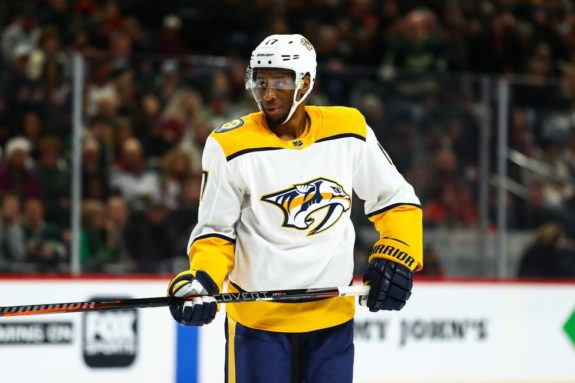
Dynamic Duo in Net
The Predators, like the Stars, have two excellent goaltenders, led by Pekka Rinne (#35). He won the 2018 Vezina Trophy and is a two-time All-Star. He’s the Predators’ franchise leader in almost every goaltending category. His 2018-19 was down by his standards with a .918 save percentage (SV%) and a 2.42 goals-against average (GAA) in 56 appearances. He had a 30-19-4 record with four shutouts.
Rinne altered his game in recent seasons, playing more upright and deeper in the net, which helps him go post-to-post smoother and be better on his angles. At 6-foot-5, he’s one of the league’s tallest netminders and is incredibly athletic, which helps him in chaos situations. Possesses a great glove hand, and when he’s on his game, is great at controlling rebounds. Best known for being one of the best goaltenders at playing the puck, and his ability to knock down dump-ins makes it difficult for opponents to set-up in the offensive zone. Rinne’s biggest hindrance has been in the postseason, where he’s struggled throughout his career. If he struggles in 2019, look for Laviolette to quickly pull him.
If he is pulled, he’ll be replaced Juuse Saros (#74). The 23-year-old is the future in net for the Predators and has received more playing time each of his three NHL seasons. He had a .915 SV% and a 2.62 GAA in 31 appearances this season. He went 17-10-2 with three shutouts. He is smaller at 5-foot-11, which means he has to be more technical rather than relying on athleticism and size. This has made him one of the more positionally-sound netminders out there.
He rarely gives up a bad rebound and sees the game at a high level, which helps him cut his angles down. Still possesses enough athleticism to bail out teammates and make highlight-reel saves. Rinne’s presence has made Saros a more consistent netminder and a better puck handler. Saros is good enough that he should get the net at the slightest hint of struggle from Rinne.
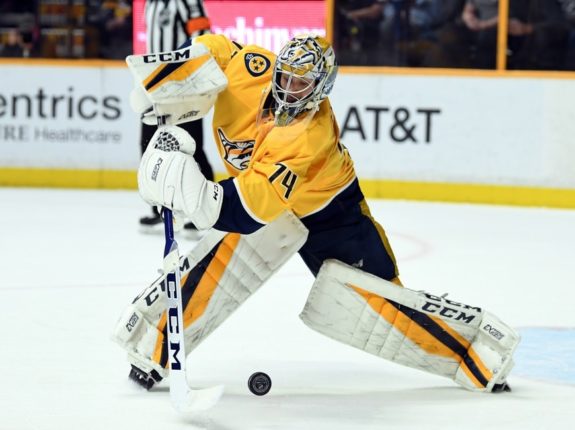
Special Teams’ Play
The Predators’ power play is terrible. In fact, at 12.9 percent, it was the league’s worst this season. Forsberg led the team with seven power-play goals. They struggled in every aspect – putting shots on net, generating scoring chances and converting chances into goals. Part of this is because they went with three forwards and two defensemen most of the season. Since the trade deadline, they generally deployed four forwards and one defenseman but still struggled to get the puck to high-danger locations. Unless something changes, their power play isn’t to be feared.
Related: A Golden Knights Fan Guide to the Sharks
Personnel-wise, one unit typically consists of Arvidsson, Boyle, Johansen and Smith, with Subban running point. When together, the unit has scored three goals and allowed no shorthanded goals. The other unit is comprised of Granlund, Forsberg, Simmonds and Turris, with Josi running point. That unit hasn’t scored any goals, nor has it allowed any.
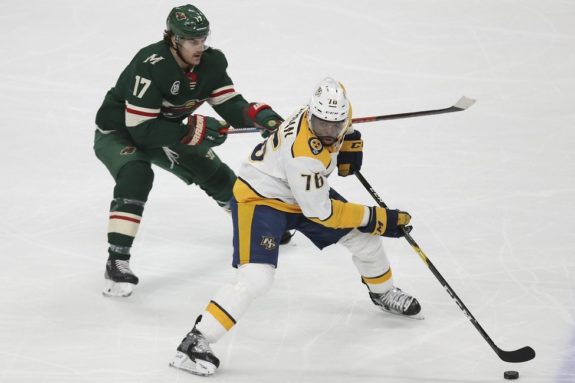
The Predators possess a more efficient penalty kill, sixth-best in the league at 82.1 percent. They were a top-10 team in terms of the number of shots and scoring chances allowed while on the penalty kill. What’s interesting about their penalty kill is that they use their most offensively-talented players, so they quickly transition from defense to offense and create scoring chances. This resulted in eight shorthanded goals, including two each by Arvidsson and Forsberg.
The forwards they used the most on the penalty kill, all with at least 50 minutes during the regular season, were Bonino, Sissons, Järnkrok, Johansen, Arvidsson, Forsberg and Watson. The defensemen are Ellis, Josi, Ekholm, Subban and Hamhuis.
What to Look For?
The Predators are a fast-paced team that performs at its best when transitioning. They play aggressively in the defensive zone, hit the streaking forward on the breakout and create odd-man rushes in the offensive zone. Once in the offensive zone, they cycle the puck well and activate their defensemen deep in the zone, creating scoring chances from all angles.
Defensively, they play a form of the trap that seeks to shutdown the opposing team at the blue line. This plays into their desire to quickly transition. Their trap system forces the opposition to dump the puck in to enter the zone, which is where Rinne’s puck-playing abilities come into play. Because they play aggressively and attack the puck carrier, they are prone to allowing premium scoring chances. When firing on all cylinders, Predators forwards defend well and play low in the defensive zone, while their defensemen activate and play deep in the offensive zone.
Related: A Jets Fan Guide to the Blues
On the power play, the Predators go point-to-point, or at least they did before changing their setup. More recently, they utilize the bumper position in the slot, but still like to go low-to-high and get shots from the points. On the penalty kill, the Predators are again an aggressive team. They pressure at the blue line and force turnovers before the opposition can enter the zone. This helps them create shorthanded scoring chances. They also pressure the puck carrier in the defensive zone, giving the opposition little time. Lastly, the Predators are a good faceoff team, and generally win the draw when shorthanded, helping to clear the puck.
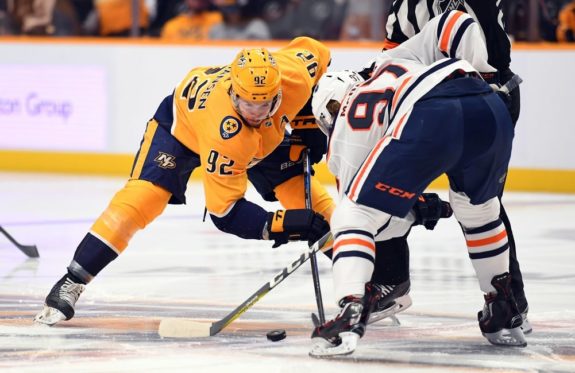
So, to all Stars fans reading this, I hope this served as a introduction to the Predators, their personnel and how they play. Again, good luck.
*All stats from Hockey-Reference